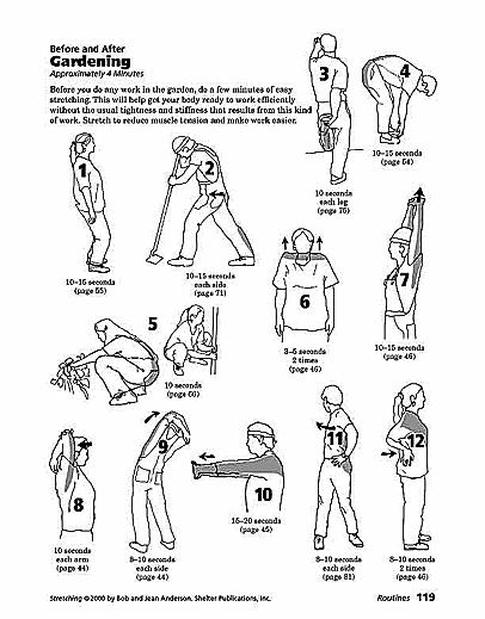
that it is time for yard work. This may include weeding, planting flowers, or getting the garden started. In our office, spring and summer weather also
signifies something. It is the onset of influx of people who have worked too long and hard in their yard, resulting in a sore back. In order to prevent this
from happening, please be conscious of the following tips while gardening or
doing yard tasks.
First of all, give your muscles a chance to warm up before working in the yard or garden. Practice stretching with the various movements you will be working in the yard, or take a short ten to fifteen-minute walk around the block.
When using a hedge trimmer, keep your back straight and use short strokes to avoid upper arm and neck strain. Don’t use wide sweeping side to side motions, as this will irritate the joints in your low back. Pause after three to five minutes. It may take longer, but your back will thank you in the long run.
Keep overhead work to five-minute episodes. This is especially true if you are holding a hedge trimmer or some other tool above your head. Avoid extreme reaching with one arm.
One the most notorious gardening activities that often results in back pain is shoveling. This activity requires repetitive bending and twisting of the back, while lifting a shovel full of material. This formula is a recipe for disaster. The lower back is generally a strong and stable part of the body. However, when used improperly, problems will arise. When shoveling, both feet should be planted firmly and the pelvis should be facing wherever the shovel is digging. When a person digs at an angle or at the side of their body, this puts the back in a vulnerable twisted
position. This is especially true when a person is digging in front of themselves and then twists to throw the dirt to a different spot. Doing this for a long period of time is really a bad idea! If a person has to move dirt from one spot to another, he or she should dig in front of them and then reposition his or her feet and pelvis to face the spot where the dirt is to be deposited. This prevents the back from twisting at all and keeps it in a safe position. Imagine sitting up straight in a flat back chair. When this curve reverses or becomes convex, the back is in a vulnerable position.
When using a wheelbarrow, the same rules apply. The back should remain straight when lifting and pushing a wheelbarrow and be sure not to twist the back. Do not fill the wheelbarrow completely full, as it will be “top-heavy”. If the wheelbarrow is in the process of tipping and a person tries hard to prevent it, this is a prime scenario for a back injury to occur.
Keep these tips in mind when doing your spring and summer yard tasks. As well, see your chiropractor prior to attempting the yard tasks so that your back is functioning at its full potential. As much as I love helping people with their low back injuries, I feel that preventing an injury from happening in the first place is much better than trying to treat it after the fact.
If you have any other questions, don’t hesitate to email me at
[email protected] or visit my website http://www.landrumdc.com.






 RSS Feed
RSS Feed
